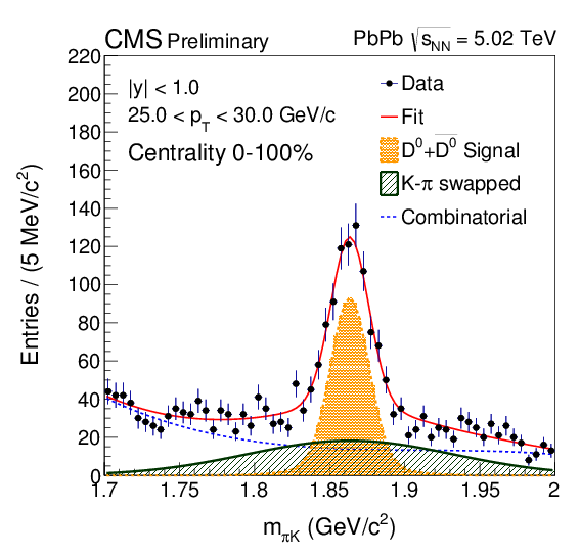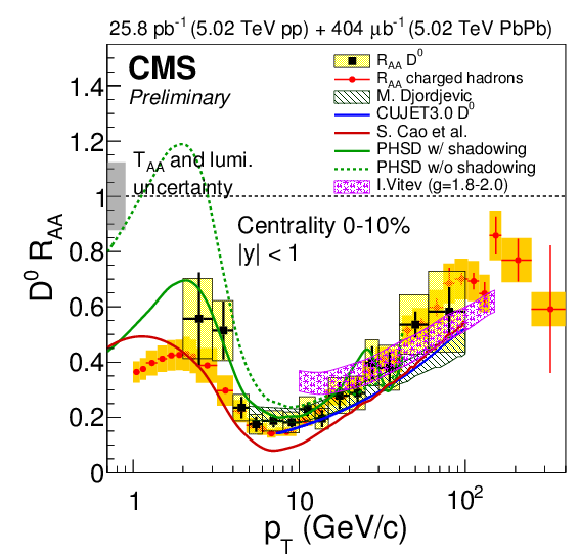

Compact Muon Solenoid
LHC, CERN
| CMS-PAS-HIN-16-001 | ||
| D0 meson nuclear modification factor in PbPb collisions at √sNN= 5.02 TeV | ||
| CMS Collaboration | ||
| June 2016 | ||
| Abstract: D0 meson production has been measured in pp and PbPb collisions at √sNN= 5.02 TeV in the central rapidity, |y|< 1 , and in the transverse momentum range between 2 and 100 GeV/c with the CMS detector at the LHC. The proton-proton dataset used for this analysis corresponds to an integrated luminosity of 25.8 pb−1, while the PbPb dataset corresponds to 404 μb−1. The measured D0 spectrum in pp collisions is well described by perturbative QCD calculations. The nuclear modification factor RAA, defined as the ratio between the corrected PbPb yield and the proton-proton cross-section scaled by the number of incoherent nucleon-nucleon collisions, was also measured. In the transverse momentum range pT= 6-10 GeV/c, the D0 yield in the PbPb collisions is suppressed by a factor of 4-5 compared to the scaled proton-proton reference. At high pT, the suppression is significantly reduced, approaching roughly a factor of 1.5 for particles with pT in the range 60-100 GeV/c. The measured D0 nuclear modification factor is compatible with the charged particle RAA, within the experimental uncertainties. | ||
|
Links:
CDS record (PDF) ;
inSPIRE record ;
CADI line (restricted) ;
These preliminary results are superseded in this paper, PLB 782 (2018) 474. The superseded preliminary plots can be found here. |
||
| Figures | |

png pdf |
Figure 1-a:
Examples of D0 candidate invariant mass distribution in pp (a) and PbPb collisions (b) at 5.02 TeV. |

png pdf |
Figure 1-b:
Examples of D0 candidate invariant mass distribution in pp (a) and PbPb collisions (b) at 5.02 TeV. |

png pdf |
Figure 2:
pT-differential cross section of prompt D0 mesons in pp collisions at √s= 5.02 TeV compared to the FONLL predictions [5]. |

png pdf |
Figure 3-a:
Nuclear modification factor RAA as a function of pT in the centrality range 0-100% (a) and 0-10% (b). The inclusive charged particle RAA results are superimposed for equivalent event selections [21]. The D0 RAA are also compared to the predictions from various theoretical calculations [22,23,24,25,26,27,28,29,30]. |

png pdf |
Figure 3-b:
Nuclear modification factor RAA as a function of pT in the centrality range 0-100% (a) and 0-10% (b). The inclusive charged particle RAA results are superimposed for equivalent event selections [21]. The D0 RAA are also compared to the predictions from various theoretical calculations [22,23,24,25,26,27,28,29,30]. |
| Summary |
| In this note, measurements of the prompt D0 production cross section and nuclear modification factor RAA in pp and PbPb collisions in the central rapidity region (|y|< 1) at √sNN= 5.02 TeV from CMS are presented. The RAA of prompt D0 mesons is measured as a function of the D0 transverse momentum from 2 to 100 GeV/c in two centrality ranges. The D0 RAA is found to be strongly suppressed in PbPb collisions when compared to the measured pp reference scaled by the number of binary nucleon-nucleon collisions. These measurements are consistent with the nuclear modification factors of charged hadrons in the corresponding centrality ranges. |
| References | ||||
| 1 | \'E. V. Shuryak | Theory of hadron plasma | Sov. Phys. JETP 47 (1978)212 | |
| 2 | J. C. Collins and M. J. Perry | Superdense Matter: Neutrons or Asymptotically Free Quarks? | PRL 34 (1975) 1353 | |
| 3 | Y. L. Dokshitzer and D. E. Kharzeev | Heavy quark colorimetry of QCD matter | PLB519 (2001) 199--206 | hep-ph/0106202 |
| 4 | N. Armesto, C. A. Salgado, and U. A. Wiedemann | Medium-induced gluon radiation off massive quarks fills the dead cone | PRD 69 (Jun, 2004) 114003 | |
| 5 | M. Cacciari, M. Greco, P. Nason | The pT Spectrum in Heavy-Flavour Hadroproduction | JHEP 007, 9805 (1998) | |
| 6 | CMS Collaboration | Prompt and non-ptompt J/ψ RAA with 150 μb−1 integrated PbPb luminosity at √sNN= 2.76 TeV | CDS | |
| 7 | CMS Collaboration | Evidence of b-Jet Quenching in PbPb Collisions at √sNN=2.76..TeV | Phys.Rev.Lett. 113 (2014), no. 13, 132301 | CMS-HIN-12-003 1312.4198 |
| 8 | CMS Collaboration | Nuclear modification factor RpA of b jets in pPb collisions | CDS | |
| 9 | CMS Collaboration | Study of B meson production in pPb collisions at √sNN= 5.02 TeV | CMS-HIN-14-004 1508.06678 |
|
| 10 | CMS Collaboration | Centrality dependence of high-pT D meson suppression in Pb-Pb collisions at √sNN= 2.76 TeV | Journal of High Energy Physics 2015 (2015), no. 11, 1--24 | |
| 11 | J. T. Adam | J. T. Adam | ||
| 12 | CMS Collaboration | The CMS experiment at the CERN LHC | JINST 3 (2008) S08004 | CMS-00-001 |
| 13 | GEANT4 Collaboration | GEANT4---a simulation toolkit | NIM506 (2003) 250 | |
| 14 | T. Sj\"ostrand, S. Mrenna, and P. Skands | PYTHIA 6.4 physics and manual | JHEP 05 (2006) 026 | hep-ph/0603175 |
| 15 | R. Field | Early LHC Underlying Event Data -- Findings and Surprises | in Hadron collider physics. Proceedings, 22nd Conference, HCP 2010, Toronto, Canada, August 23-27, 2010 2010 | 1010.3558 |
| 16 | I. P. Lokhtin and A. M. Snigirev | A model of jet quenching in ultrarelativistic heavy ion collisions and high-\pt hadron spectra at RHIC | EPJC45 (2006) 211 | hep-ph/0506189 |
| 17 | D. Lange | The EvtGen particle decay simulation package | Nucl.Instrum.Meth. A462 (2001) 152--155 | |
| 18 | E. Barberio, B. van Eijk, and Z. Was | PHOTOS: A Universal Monte Carlo for QED radiative corrections in decays | Comput.Phys.Commun. 66 (1991) 115--128 | |
| 19 | Particle Data Group Collaboration | Review of Particle Physics (RPP) | Phys.Rev. D86 (2012) 010001 | |
| 20 | CMS Collaboration | Measurement of tracking efficiency | CDS | |
| 21 | CMS Collaboration | CMS Collaboration | ||
| 22 | J. Xu, J. Liao, and M. Gyulassy | Bridging Soft-Hard Transport Properties of Quark-Gluon Plasmas with CUJET3.0 | JHEP 02 (2016) 169 | 1508.00552 |
| 23 | J. Xu, A. Buzzatti, and M. Gyulassy | Azimuthal jet flavor tomography with CUJET2.0 of nuclear collisions at RHIC and LHC | JHEP 08 (2014) 063 | 1402.2956 |
| 24 | X. Jiechen, L. Jinfeng, and M. Gyulassy | Consistency of Perfect Fluidity and Jet Quenching in Semi-Quark-Gluon Monopole Plasmas | Chinese Physics Letters 32 (2015), no. 9, 092501 | |
| 25 | M. Djordjevic and M. Djordjevic | Predictions of heavy-flavor suppression at 5.1 TeV Pb + Pb collisions at the CERN Large Hadron Collider | PRC 92 (Aug, 2015) 024918 | |
| 26 | G.-Y. Q. X.-N. W. Shanshan Cao, Tan Luo | A Linearized Boltzmann transport model for jet propagation in the quark-gluon plasma: Heavy quark evolution. | 1605.06447v1 | |
| 27 | T. Song et al. | Tomography of the quark-gluon plasma by charm quarks | PRC 92 (Jul, 2015) 014910 | |
| 28 | T. Song et al. | Charm production in Pb + Pb collisions at energies available at the CERN Large Hadron Collider | PRC 93 (Mar, 2016) 034906 | |
| 29 | Z.-B. Kang et al. | Jet Quenching Phenomenology from Soft-Collinear Effective Theory with Glauber Gluons | PRL 114 (Mar, 2015) 092002 | |
| 30 | Y.-T. Chien et al. | Jet quenching from QCD evolution | PRD 93 (Apr, 2016) 074030 | |
| 31 | S. J. S. M. L. Miller, K. Reygers and P. Steinberg | Glauber modeling in high-energy nuclear collisions | technical report | |

|
Compact Muon Solenoid LHC, CERN |

|

|

|

|

|

|